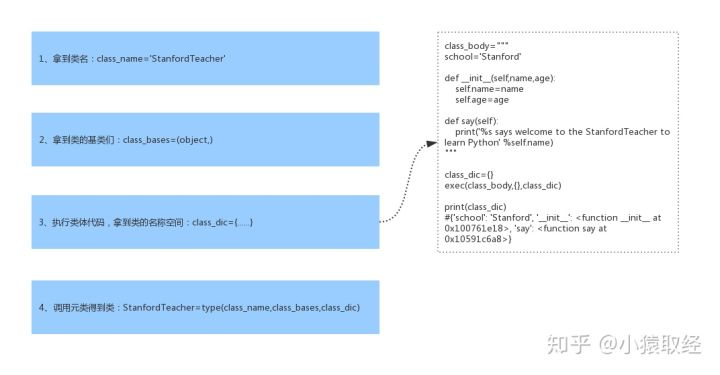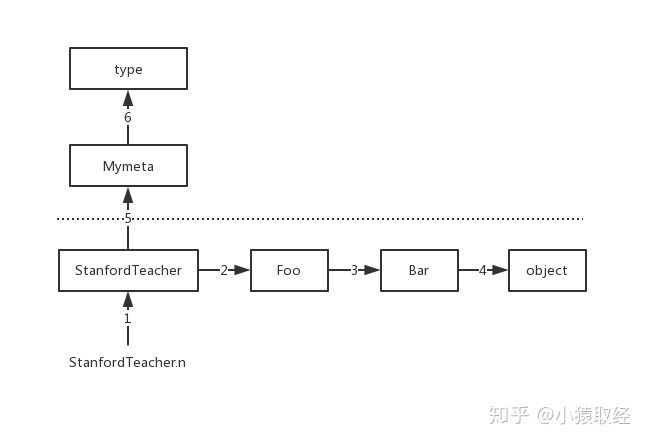https://zhuanlan.zhihu.com/p/109336845
元类的介绍
什么是元类呢?一切源自于一句话:python中一切皆为对象。让我们先定义一个类,然后逐步分析
class StanfordTeacher(object): school='Stanford' def __init__(self,name,age): self.name=name self.age=age def say(self): print('%s says welcome to the Stanford to learn Python' %self.name)
所有的对象都是实例化或者说调用类而得到的(调用类的过程称为类的实例化),比如对象t1是调用类StanfordTeacher得到的
t1=StanfordTeacher('lili',18) print(type(t1)) #查看对象t1的类是<class '__main__.StanfordTeacher'>
如果一切皆为对象,那么类StanfordTeacher本质也是一个对象,既然所有的对象都是调用类得到的,那么StanfordTeacher必然也是调用了一个类得到的,这个类称为元类
于是我们可以推导出===>产生StanfordTeacher的过程一定发生了:StanfordTeacher=元类(...)
print(type(StanfordTeacher)) # 结果为<class 'type'>,证明是调用了type这个元类而产生的StanfordTeacher,即默认的元类为type

class关键字创建类的流程分析
上文我们基于python中一切皆为对象的概念分析出:我们用class关键字定义的类本身也是一个对象,负责产生该对象的类称之为元类(元类可以简称为类的类),内置的元类为type
class关键字在帮我们创建类时,必然帮我们调用了元类StanfordTeacher=type(...),那调用type时传入的参数是什么呢?必然是类的关键组成部分,一个类有三大组成部分,分别是
1、类名class_name='StanfordTeacher' 2、基类们class_bases=(object,) 3、类的名称空间class_dic,类的名称空间是执行类体代码而得到的
调用type时会依次传入以上三个参数
综上,class关键字帮我们创建一个类应该细分为以下四个过程

示例:不使用class关键字创建类

# 类有三大特征: # 1、类名 class_name="People" # 2、类的基类 class_bases=(object,) # 3、执行类体代码拿到类的名称空间 class_dic={"school":"school"} class_body=""" def __init__(self,name,age): self.name=name self.age=age def print_school(self): print(school) def say(self): print('%s:%s' %(self.name,self.name)) def print_school(self): print(self.school) """ exec(class_body,{},class_dic) # print(class_dic) # 4、调用元类 People=type(class_name,class_bases,class_dic) p1=People("egon",18) p1.print_school() #school
补充:exec的用法
#exec:三个参数 #参数一:包含一系列python代码的字符串 #参数二:全局作用域(字典形式),如果不指定,默认为globals() #参数三:局部作用域(字典形式),如果不指定,默认为locals() #可以把exec命令的执行当成是一个函数的执行,会将执行期间产生的名字存放于局部名称空间中 g={ 'x':1, 'y':2 } l={} exec(''' global x,z x=100 z=200 m=300 ''',g,l) print(g) #{'x': 100, 'y': 2,'z':200,......} print(l) #{'m': 300}
自定义元类控制类StanfordTeacher的创建
一个类没有声明自己的元类,默认他的元类就是type,除了使用内置元类type,我们也可以通过继承type来自定义元类,然后使用metaclass关键字参数为一个类指定元类
class Mymeta(type): #只有继承了type类才能称之为一个元类,否则就是一个普通的自定义类 pass # StanfordTeacher=Mymeta('StanfordTeacher',(object),{...}) class StanfordTeacher(object,metaclass=Mymeta): school='Stanford' def __init__(self,name,age): self.name=name self.age=age def say(self): print('%s says welcome to the Stanford to learn Python' %self.name)
自定义元类可以控制类的产生过程,类的产生过程其实就是元类的调用过程,即StanfordTeacher=Mymeta('StanfordTeacher',(object),{...}),调用Mymeta会先产生一个空对象StanfordTeacher,然后连同调用Mymeta括号内的参数一同传给Mymeta下的__init__方法,完成初始化,于是我们可以
class Mymeta(type): # 只有继承了type类的类才是元类 # 空对象,"People",(object,),{...} #类名,基类,类的名称空间 def __init__(self,class_name,class_bases,class_dic): # print('run....') # print(self.__name__) # print(class_name) # print(class_bases,self.__bases__) # print(class_dic) super(Mymeta, self).__init__(class_name,class_bases,class_dic) # if not class_name.istitle(): # raise NameError('类名的首字母必须大写,其余小写!!!') if "__doc__" not in class_dic or len(class_dic["__doc__"].strip(" ")) == 0: raise TypeError('类中必须有文档注释,并且文档注释不能为空') # StanfordTeacher=Mymeta("StanfordTeacher",(object,),{...}) # 调用Mymeta发生三件事,调用Mymeta就是type.__call__ # 1、先造一个空对象=>StanfordTeacher,调用Mymeta类内的__new__方法 # 2、调用Mymeta这个类内的__init__方法,完成初始化对象的操作 # 3、返回初始化好的对象 class StanfordTeacher(object,metaclass=Mymeta): #metaclass=Mymeta 设置元类 """ 注释 """ def __init__(self,name,age): self.name=name self.age=age def say(self): print('%s:%s' %(self.name,self.age)) p1=StanfordTeacher("egon",18) p1.say() #egon:18
自定义元类控制类StanfordTeacher的调用
储备知识:__call__
class Foo: def __call__(self, *args, **kwargs): print(self) print(args) print(kwargs) obj=Foo() #1、要想让obj这个对象变成一个可调用的对象,需要在该对象的类中定义一个方法__call__方法,该方法会在调用对象时自动触发 #2、调用obj的返回值就是__call__方法的返回值 res=obj(1,2,3,x=1,y=2)
由上例得知,调用一个对象,就是触发对象所在类中的__call__方法的执行,如果把StanfordTeacher也当做一个对象,那么在StanfordTeacher这个对象的类中也必然存在一个__call__方法
class Mymeta(type): #只有继承了type类才能称之为一个元类,否则就是一个普通的自定义类 def __call__(self, *args, **kwargs): print(self) #<class '__main__.StanfordTeacher'> print(args) #('lili', 18) print(kwargs) #{} return 123 class StanfordTeacher(object,metaclass=Mymeta): school='Stanford' def __init__(self,name,age): self.name=name self.age=age def say(self): print('%s says welcome to the Stanford to learn Python' %self.name) # 调用StanfordTeacher就是在调用StanfordTeacher类中的__call__方法 # 然后将StanfordTeacher传给self,溢出的位置参数传给*,溢出的关键字参数传给** # 调用StanfordTeacher的返回值就是调用__call__的返回值 t1=StanfordTeacher('lili',18) print(t1) #123
更进一步:
class Mymeta(type): # 只有继承了type类的类才是元类 def __call__(self, *args, **kwargs): # 1、Mymeta.__call__函数内会先调用People内的__new__ people_obj=self.__new__(self) # 2、Mymeta.__call__函数内会调用People内的__init__ self.__init__(people_obj,*args, **kwargs) # print('people对象的属性:',people_obj.__dict__) people_obj.__dict__['xxxxx']=11111 # 3、Mymeta.__call__函数内会返回一个初始化好的对象 return people_obj # 类的产生 # People=Mymeta()=》type.__call__=>干了3件事 # 1、type.__call__函数内会先调用Mymeta内的__new__ # 2、type.__call__函数内会调用Mymeta内的__init__ # 3、type.__call__函数内会返回一个初始化好的对象 class People(metaclass=Mymeta): def __init__(self,name,age): self.name=name self.age=age def say(self): print('%s:%s' %(self.name,self.name)) def __new__(cls, *args, **kwargs): # 产生真正的对象 return object.__new__(cls) # 类的调用 # obj=People('egon',18) =》Mymeta.__call__=》干了3件事 # 1、Mymeta.__call__函数内会先调用People内的__new__ # 2、Mymeta.__call__函数内会调用People内的__init__ # 3、Mymeta.__call__函数内会返回一个初始化好的对象 obj1=People('egon',18) obj2=People('egon',18) # print(obj) print(obj1.__dict__) print(obj2.__dict__) ''' 执行结果 {'name': 'egon', 'age': 18, 'xxxxx': 11111} {'name': 'egon', 'age': 18, 'xxxxx': 11111} '''
上例中涉及到查找属性的问题,比如self.__new__,请看下一小节
#控制类的产生,在元类中定义 __new__ __init__ #控制类的调用,在元类中定义 __call__
属性查找:
结合python继承的实现原理+元类重新看属性的查找应该是什么样子呢???
在学习完元类后,其实我们用class自定义的类也全都是对象(包括object类本身也是元类type的 一个实例,可以用type(object)查看),我们学习过继承的实现原理,如果把类当成对象去看,将下述继承应该说成是:对象StanfordTeacher继承对象Foo,对象Foo继承对象Bar,对象Bar继承对象object
class Mymeta(type): #只有继承了type类才能称之为一个元类,否则就是一个普通的自定义类 n=444 def __call__(self, *args, **kwargs): #self=<class '__main__.StanfordTeacher'> obj=self.__new__(self) self.__init__(obj,*args,**kwargs) return obj class Bar(object): n=333 class Foo(Bar): n=222 class StanfordTeacher(Foo,metaclass=Mymeta): n=111 school='Stanford' def __init__(self,name,age): self.name=name self.age=age def say(self): print('%s says welcome to the Stanford to learn Python' %self.name) print(StanfordTeacher.n) #自下而上依次注释各个类中的n=xxx,然后重新运行程序,发现n的查找顺序为StanfordTeacher->Foo->Bar->object->Mymeta->type
于是属性查找应该分成两层,一层是对象层(基于c3算法的MRO)的查找,另外一个层则是类层(即元类层)的查找

#查找顺序: #1、先对象层:StanfordTeacher->Foo->Bar->object #2、然后元类层:Mymeta->type
依据上述总结,我们来分析下元类Mymeta中__call__里的self.__new__的查找
class Mymeta(type): n=444 def __call__(self, *args, **kwargs): #self=<class '__main__.StanfordTeacher'> obj=self.__new__(self) print(self.__new__ is object.__new__) #True class Bar(object): n=333 # def __new__(cls, *args, **kwargs): # print('Bar.__new__') class Foo(Bar): n=222 # def __new__(cls, *args, **kwargs): # print('Foo.__new__') class StanfordTeacher(Foo,metaclass=Mymeta): n=111 school='Stanford' def __init__(self,name,age): self.name=name self.age=age def say(self): print('%s says welcome to the Stanford to learn Python' %self.name) # def __new__(cls, *args, **kwargs): # print('StanfordTeacher.__new__') StanfordTeacher('lili',18) #触发StanfordTeacher的类中的__call__方法的执行,进而执行self.__new__开始查找
总结,Mymeta下的__call__里的self.__new__在StanfordTeacher、Foo、Bar里都没有找到__new__的情况下,会去找object里的__new__,而object下默认就有一个__new__,所以即便是之前的类均未实现__new__,也一定会在object中找到一个,根本不会、也根本没必要再去找元类Mymeta->type中查找__new__
我们在元类的__call__中也可以用object.__new__(self)去造对象
class Mymeta(type): n=444 def __call__(self, *args, **kwargs): #self=<class '__main__.StanfordTeacher'> # obj=self.__new__(self) # StanfordTeacher.__new__ obj=object.__new__(self) self.__init__(obj,*args,**kwargs) return obj class Bar(object): # n=333 # def __new__(cls, *args, **kwargs): # print('Bar.__new__') pass class Foo(Bar): # n=222 # def __new__(cls, *args, **kwargs): # print('Foo.__new__') pass class StanfordTeacher(Foo,metaclass=Mymeta): n=111 def __init__(self,name,age): self.name=name self.age=age obj=StanfordTeacher('lili',18) print(obj.__dict__) #{'name': 'lili', 'age': 18} # print(obj.n) # print(StanfordTeacher.n)
但我们还是推荐在__call__中使用self.__new__(self)去创造空对象,因为这种方式会检索三个类StanfordTeacher->Foo->Bar,而object.__new__则是直接跨过了他们三个

示例:在元类中控制把自定义类的数据属性都变成大写
class Mymetaclass(type): def __new__(cls,name,bases,attrs): update_attrs={} for k,v in attrs.items(): if not callable(v) and not k.startswith('__'): update_attrs[k.upper()]=v else: update_attrs[k]=v return type.__new__(cls,name,bases,update_attrs) class Chinese(metaclass=Mymetaclass): country='China' tag='Legend of the Dragon' #龙的传人 def walk(self): print('%s is walking' %self.name) print(Chinese.__dict__) ''' {'__module__': '__main__', 'COUNTRY': 'China', 'TAG': 'Legend of the Dragon', 'walk': <function Chinese.walk at 0x0000000001E7B950>, '__dict__': <attribute '__dict__' of 'Chinese' objects>, '__weakref__': <attribute '__weakref__' of 'Chinese' objects>, '__doc__': None} '''
示例2:在元类中控制自定义的类无需__init__方法
1.元类帮其完成创建对象,以及初始化操作;
2.要求实例化时传参必须为关键字形式,否则抛出异常TypeError: must use keyword argument
3.key作为用户自定义类产生对象的属性,且所有属性变成大写
class Mymetaclass(type): # def __new__(cls,name,bases,attrs): # update_attrs={} # for k,v in attrs.items(): # if not callable(v) and not k.startswith('__'): # update_attrs[k.upper()]=v # else: # update_attrs[k]=v # return type.__new__(cls,name,bases,update_attrs) def __call__(self, *args, **kwargs): if args: raise TypeError('must use keyword argument for key function') obj = object.__new__(self) #创建对象,self为类Foo for k,v in kwargs.items(): obj.__dict__[k.upper()]=v return obj class Chinese(metaclass=Mymetaclass): country='China' tag='Legend of the Dragon' #龙的传人 def walk(self): print('%s is walking' %self.name) p=Chinese(name='lili',age=18,sex='male') print(p.__dict__)
示例3:在元类中控制自定义的类产生的对象相关的属性全部为隐藏属性
class Mymeta(type): def __init__(self,class_name,class_bases,class_dic): #控制类Foo的创建 super(Mymeta,self).__init__(class_name,class_bases,class_dic) def __call__(self, *args, **kwargs): #控制Foo的调用过程,即Foo对象的产生过程 obj = self.__new__(self) self.__init__(obj, *args, **kwargs) obj.__dict__={'_%s__%s' %(self.__name__,k):v for k,v in obj.__dict__.items()} return obj class Foo(object,metaclass=Mymeta): # Foo=Mymeta(...) def __init__(self, name, age,sex): self.name=name self.age=age self.sex=sex obj=Foo('lili',18,'male') print(obj.__dict__)
示例4:基于元类实现单例模式
#步骤五:基于元类实现单例模式 # 单例:即单个实例,指的是同一个类实例化多次的结果指向同一个对象,用于节省内存空间 # 如果我们从配置文件中读取配置来进行实例化,在配置相同的情况下,就没必要重复产生对象浪费内存了 #settings.py文件内容如下 HOST='1.1.1.1' PORT=3306 #方式一:定义一个类方法实现单例模式 import settings class Mysql: __instance=None def __init__(self,host,port): self.host=host self.port=port @classmethod def singleton(cls): if not cls.__instance: cls.__instance=cls(settings.HOST,settings.PORT) return cls.__instance obj1=Mysql('1.1.1.2',3306) obj2=Mysql('1.1.1.3',3307) print(obj1 is obj2) #False obj3=Mysql.singleton() obj4=Mysql.singleton() print(obj3 is obj4) #True #方式二:定制元类实现单例模式(可以看下面__init__和__new__的例子) import settings class Mymeta(type): def __init__(self,name,bases,dic): #定义类Mysql时就触发 # 事先先从配置文件中取配置来造一个Mysql的实例出来 self.__instance = object.__new__(self) # 产生对象 self.__init__(self.__instance, settings.HOST, settings.PORT) # 初始化对象 # 上述两步可以合成下面一步 # self.__instance=super().__call__(*args,**kwargs) super().__init__(name,bases,dic) def __call__(self, *args, **kwargs): #Mysql(...)时触发 if args or kwargs: # args或kwargs内有值 obj=object.__new__(self) self.__init__(obj,*args,**kwargs) return obj return self.__instance class Mysql(metaclass=Mymeta): def __init__(self,host,port): self.host=host self.port=port obj1=Mysql() # 没有传值则默认从配置文件中读配置来实例化,所有的实例应该指向一个内存地址 obj2=Mysql() obj3=Mysql() print(obj1 is obj2 is obj3) obj4=Mysql('1.1.1.4',3307) #方式三:定义一个装饰器实现单例模式 import settings def singleton(cls): #cls=Mysql _instance=cls(settings.HOST,settings.PORT) def wrapper(*args,**kwargs): if args or kwargs: obj=cls(*args,**kwargs) return obj return _instance return wrapper @singleton # Mysql=singleton(Mysql) class Mysql: def __init__(self,host,port): self.host=host self.port=port obj1=Mysql() obj2=Mysql() obj3=Mysql() print(obj1 is obj2 is obj3) #True obj4=Mysql('1.1.1.3',3307) obj5=Mysql('1.1.1.4',3308) print(obj3 is obj4) #False

class Singleton(type): def __init__(self, *args, **kwargs): print("__init__") self.__instance = None # super(Singleton,self).__init__(*args, **kwargs) def __call__(self, *args, **kwargs): print("__call__") if self.__instance is None: self.__instance = super(Singleton,self).__call__(*args, **kwargs) return self.__instance class Foo(object,metaclass=Singleton): #在代码执行到这里的时候,元类中的__new__方法和__init__方法其实已经被执行了,而不是在Foo实例化的时候执行。且仅会执行一次。 def __init__(self,name,age): self.name=name self.age=age foo1 = Foo("egon",18) foo2 = Foo("alex",20) print(Foo.__dict__ ) #_Singleton__instance': <__main__.Foo object at 0x100c52f10> 存在一个私有属性来保存属性,而不会污染Foo类(其实还是会污染,只是无法直接通过__instance属性访问) print(foo1 is foo2) # True

class Singleton(type): def __new__(cls, name, bases, attrs): print("__new__") attrs["_instance"] = None return super(Singleton, cls).__new__(cls, name, bases, attrs) def __call__(self, *args, **kwargs): print("__call__") if self._instance is None: self._instance = super(Singleton,self).__call__(*args, **kwargs) return self._instance class Foo(object,metaclass=Singleton): #在代码执行到这里的时候,元类中的__new__方法和__init__方法其实已经被执行了,而不是在Foo实例化的时候执行。且仅会执行一次。 def __init__(self,name,age): self.name=name self.age=age foo1 = Foo("egon",18) foo2 = Foo("alex",20) print(Foo.__dict__ ) #_Singleton__instance': <__main__.Foo object at 0x100c52f10> 存在一个私有属性来保存属性,而不会污染Foo类(其实还是会污染,只是无法直接通过__instance属性访问) print(foo1 is foo2) # True

#一种定义None def singleton_wrapper(cls): # cls ---> Too _instance=None def inner(*args, **kwargs): nonlocal _instance # 若当前装饰的类不在字典中,则实例化新类 # 判断当前装饰的Too类是否在字典中 if not _instance: # obj = cls(*args, **kwargs) # return obj # 不在,则给字典添加 key为Too, value为Too()---> 实例对象 # {Too: Too(*args, **kwargs)} _instance = cls(*args, **kwargs) # return 对应的实例对象cls(*args, **kwargs) return _instance return inner @singleton_wrapper # singleton_wrapper(Too) class Too(object): def __init__(self,name): self.name=name def p_name(self): print(self.name) t1 = Too("egon") t2 = Too("alex") print(t1 is t2) # True t1.p_name() t2.p_name() """ True egon egon """ #定义成一个字典 def singleton_wrapper(cls): # cls ---> Too # 因为装饰器可以给多个类使用,所以这里采用字典 # 以类作为key, 实例对象作为value值 _instance = { # 伪代码: 'Too': Too的示例对象 } def inner(*args, **kwargs): # 若当前装饰的类不在字典中,则实例化新类 # 判断当前装饰的Too类是否在字典中 if cls not in _instance: # obj = cls(*args, **kwargs) # return obj # 不在,则给字典添加 key为Too, value为Too()---> 实例对象 # {Too: Too(*args, **kwargs)} _instance[cls] = cls(*args, **kwargs) # return 对应的实例对象cls(*args, **kwargs) return _instance[cls] return inner @singleton_wrapper # singleton_wrapper(Too) class Too(object): def __init__(self,name): self.name=name def p_name(self): print(self.name) t1 = Too("egon") t2 = Too("alex") print(t1 is t2) # True t1.p_name() t2.p_name() """ True egon egon """
导入模块实现单例
''' 单例模式: 单例模式是一个软件的设计模式,为了保证一个类,无论调用多少次产生的实例对象, 都是指向同一个内存地址,仅仅只有一个实例(对象)! 五种单例: - 模块 - 装饰器 - 元类 - __new__ - 类方法: classmethod ''' 方式五: 模块导入实现 ''' import cls_singleton s1 = cls_singleton.instance s2 = cls_singleton.instance print(s1 is s2) # True
